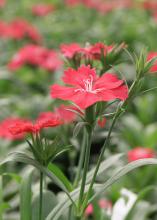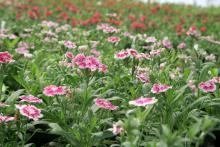Information Possibly Outdated
The information presented on this page was originally released on November 17, 2010. It may not be outdated, but please search our site for more current information. If you plan to quote or reference this information in a publication, please check with the Extension specialist or author before proceeding.
Telstar dianthus bring spring color to winter
Some of my favorite spring flowers are annual and perennial dianthus, with their wide variety of pinks, whites, and purples, but you don’t have to wait for warmer temperatures to enjoy colorful dianthus.
Annual landscape dianthus hybrids, such as Telstar dianthus, will add color and interest to your landscape right through fall and winter.
Since I moved to south Mississippi, Telstar dianthus has become one of my favorite cool-season plants. The flowers have a dainty, floral fragrance and come in carmine rose, pink, white and purple picotee. They have a fringed margin and are available in single, double and semidouble petal arrangements.
The dianthus colors available in the fall are from the same color palette as the spring and summer varieties, so you can have color continuity in your landscape throughout the year.
Telstar dianthus will grow 8 to 10 inches tall. Be sure to space them about 8 inches apart in order to have beautiful and fully massed landscape beds. They also make elegant border plantings.
The bushy plants have a stout structure with linear, toothed foliage that resembles the foliage of garden carnations. This is not surprising, as both are in the same family.
To ensure repeated flowering, prune 2 to 3 inches from the plants after the first flowering flush. The plants will recover quickly and reward you with continued flowering. For optimum landscape performance, plant in full sun in well-drained soil amended with quality composted material.
Fertilize when you transplant them, using 1 to 2 pounds of a high-quality, slow-release fertilizer per 100 square feet of bed space. Telstar dianthus are vigorous growers and bloomers, so supplement with a water-soluble fertilizer monthly through the winter season. This will keep the flowers coming.
In southern Mississippi, which is zone 8, plant Telstar dianthus in the fall and winter, from November through March. In northern Mississippi, which is zone 7, plant in April and May and August and September.
When the temperatures get too low, the flowers will take a hit, and foliage will turn a little bronze or purple. The plants will recover when temperatures moderate. Apply a layer of mulch to protect the plant crown and conserve soil moisture as spring nears.
Planting Telstar dianthus in the fall, especially in southern Mississippi, allows the plants to develop robust root systems and provides an even better flowering display in the spring. Fall planting is also ideal for some of Telstar dianthus’ planting partners.
Pair Telstar dianthus with other cool-season, flowering annuals, such as pansy or viola. These are sure-fire pairings that will last all winter and continue showing off well into the spring and early summer. You could also try a combination planting in the fall with a complementary or contrasting color of petunia.
-30-
Released: November 17, 2010
Contact: Dr. Gary Bachman, (228) 546-1009
Editor's Note: Ideal publication dates of Southern Gardening columns are within one month of their release. Editors should examine older columns carefully for any information that could be time sensitive.









